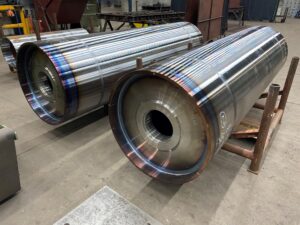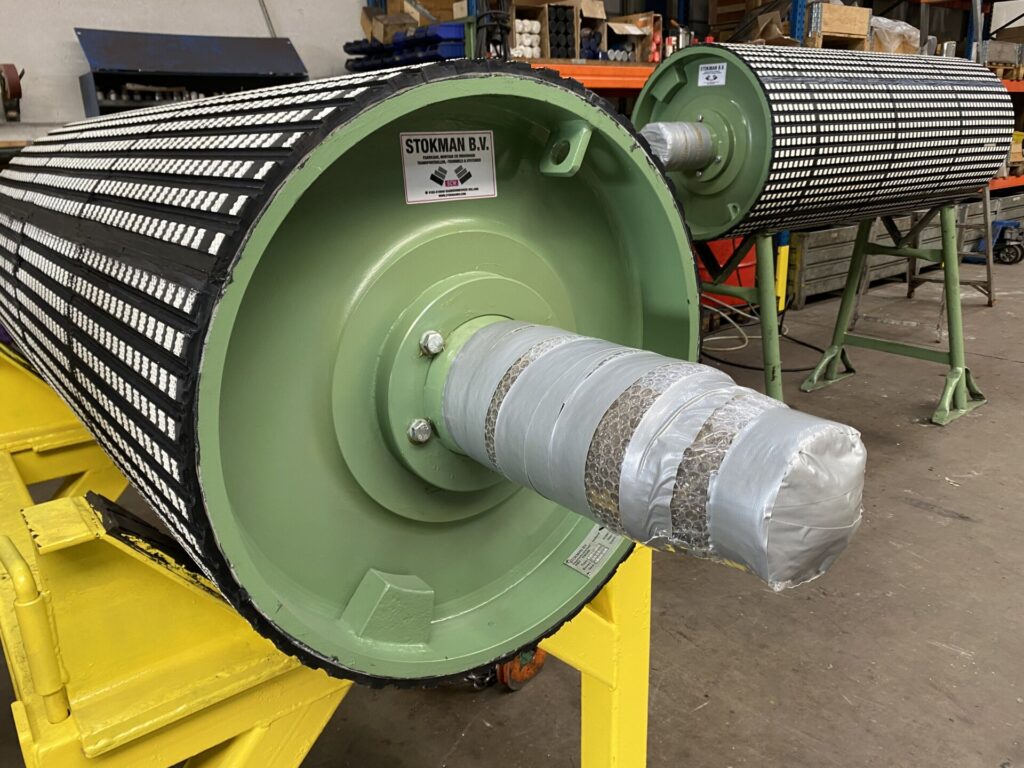Design and production of Stokman pulleys
Would you like to know how your new Stokman pulley is made? In this blog, we will explain! The pulleys in your system are essential for the reliability of the installation. We will produce them with great care in our factory in Raamsdonksveer. In this blog we describe the different stages of the production process and what factors influence the design of pulleys.
The pulleys in a conveyor system are essential for the correct and reliable operation of the system. They are perhaps the most important parts of the entire installation. A worn conveyor roller can be relatively quickly replaced. Spare rollers are usually stocked item. Usually pulleys are not in stock. Their failure will lead to downtime of the entire conveyor and possibly the entire plant. This unexpected downtime and delays in the production process are unexpected costs.
Stokman pulleys are of the highest quality and prepared for their application. Our quality comes from experience gained over 100 years which is passed down from one generation to the next.
Factors in design and construction of pulleys
Our pulleys are custom designed and manufactured to the specific requirements of your conveyor system. The load on the pulley determines the design. There are 4 important factors:
- Volume of material per hour
- Speed
- Dimensions of the conveyor belt
- Transport height
We will use this information to calculate the required tractive forces and the total required driving force of the conveyor. This is how we can determine how many driving pulleys are required and at which locations in the installation they must be placed.
The other pulleys in the installation must be able to withstand the tensile forces of the belt. The loads on those pulleys depend on factors like the position in the installation and the length of the tensioned conveyor belt. As a rule of thumb, the greater the length of the tensioned conveyor belt the higher the load on the pulley. This is important when we design the pulley.
Peak load conveyor belt and pulley
Another factor for the pulley design is the forces that occur during the loading of material. Finally, we look at the additional power required to restart the entire system after an unexpected shutdown, at a time when the system is fully loaded with material.
Parts of the pulleys
The pulleys consist of 3 standard parts: the casing, shields and shaft. We make these 3 parts in our factory in Raamsdonksveer. In consultation with the customer, pulleys can be supplied with or without bearing housings.
Drive pulleys are always supplied with external bearing housings. Non-drive pulleys can be supplied with either external or internal bearings. The choice of an internally or externally mounted pulley is mainly determined by the design of the belt line and the requirements and/or possibilities of the customer. Pulleys with internal bearings are more compact and often easier to install in connection with bearing alignment. However, if a bearing breaks down a customer can easily replace an external bearing.
Construction of the pulleys
 The construction of Stokman pulleys can be divided into 4 different phases:
The construction of Stokman pulleys can be divided into 4 different phases:
- Manufacturing parts and assembling the pulley body
- Finishing and lining
- Balancing
- Finishing
Manufacturing parts and assembling the pulley body
The casing, shields and shaft are manufactured in our factory in Raamsdonksveer. Then the casing and shields are assembled by a welding robot developed at Stokman. After welding, low-tension annealing is part of the standard process.
During welding, parts including the pulley body become very hot causing the steel to expand. After welding, the pulley body cools back to ambient temperature and the steel shrinks again. However, the individual parts cannot completely shrink back to their original dimensions because they are welded together. This creates unwanted stresses in the material, especially at the welded joints. These are called shrinkage stresses. As high stresses already occur in the material due to the load on the pulley, we want to reduce any additional shrinkage stresses as much as possible.
Heating the pulley in an oven at a high temperature for several hours will gradually dissipate the shrinkage stresses in the material.
Finishing and lining
After the low-tension annealing the pulley body is machined to the correct dimensions. If a pulley is to be lined, the surface to be bonded is blasted for proper adhesion.
Not all of our pulleys are lined, this depends on the requirements for the installation. We will line the pulley body in a special room in our workshop. After finishing and possible lining, the pulley shaft and pulley body are assembled.
Balancing
A balanced pulley is essential for the correct operation of the plant. If the pulley is not balanced, unwanted vibrations will arise in the pulley and its supporting structure during operation. These vibrations can cause excessive wear on the pulley and its construction. As a result, the structure may fail in extreme cases.
Balancing a pulley works uses the same principle as aligning the wheels of a car. We apply a steel block to the inside of the casing to provide additional weight. We will place this at the spot that the pulley is balanced in any position. This spot is depends on the other properties of the pulley such as length, weight and diameter. An unbalanced pulley eill continue to rotate until the center of gravity is at the very bottom.
Finishing
When the pulley is balanced, only the finishing remain. Our pulleys are preserved with an anti-corrosion paint system. The paint system consists of several layers of paint and can be applied in almost any RAL colour. The standard colour is green. Each Stokman pulley is provided with a unique identification plate, stating the order number, weight, year of manufacture of the pulley and possibly a warehouse code of our customer.
What do you expect from your new conveyor belt pulleys? We would be happy to discuss the many possibilities of our pulleys with you. Please, feel free to contact us and choose the well-known Stokman quality.


